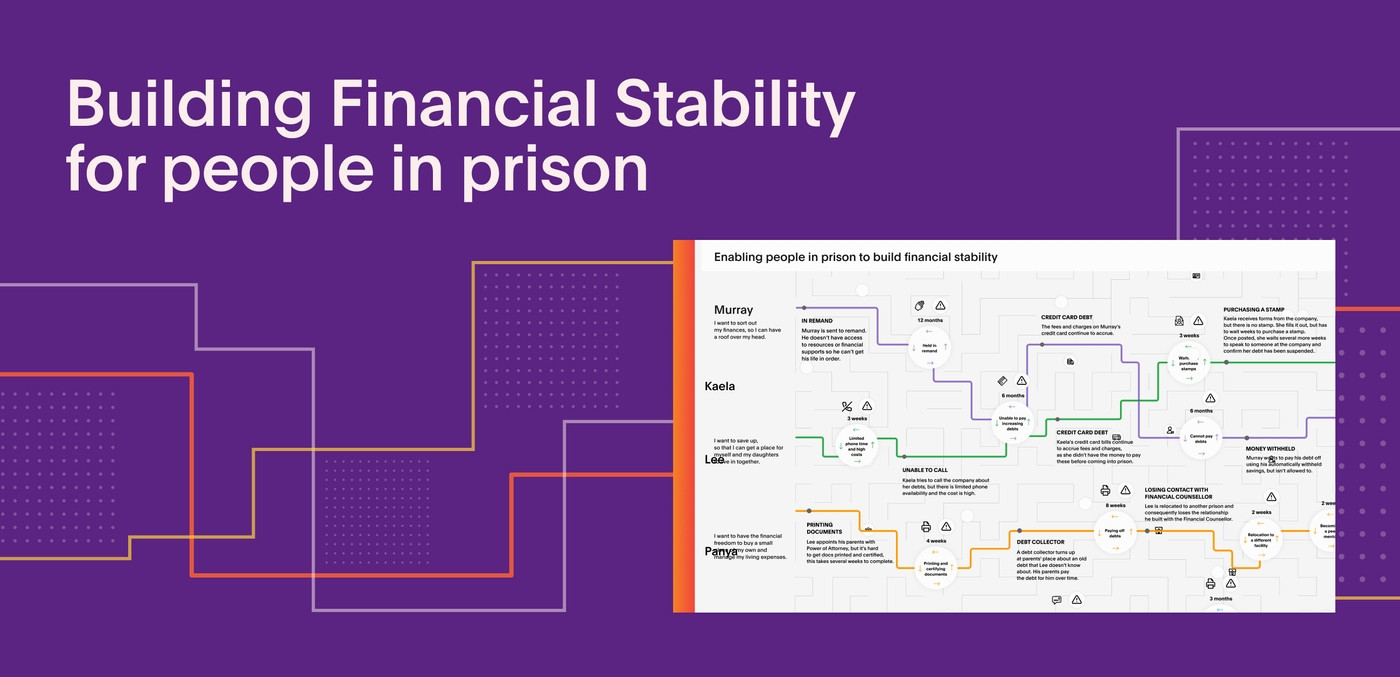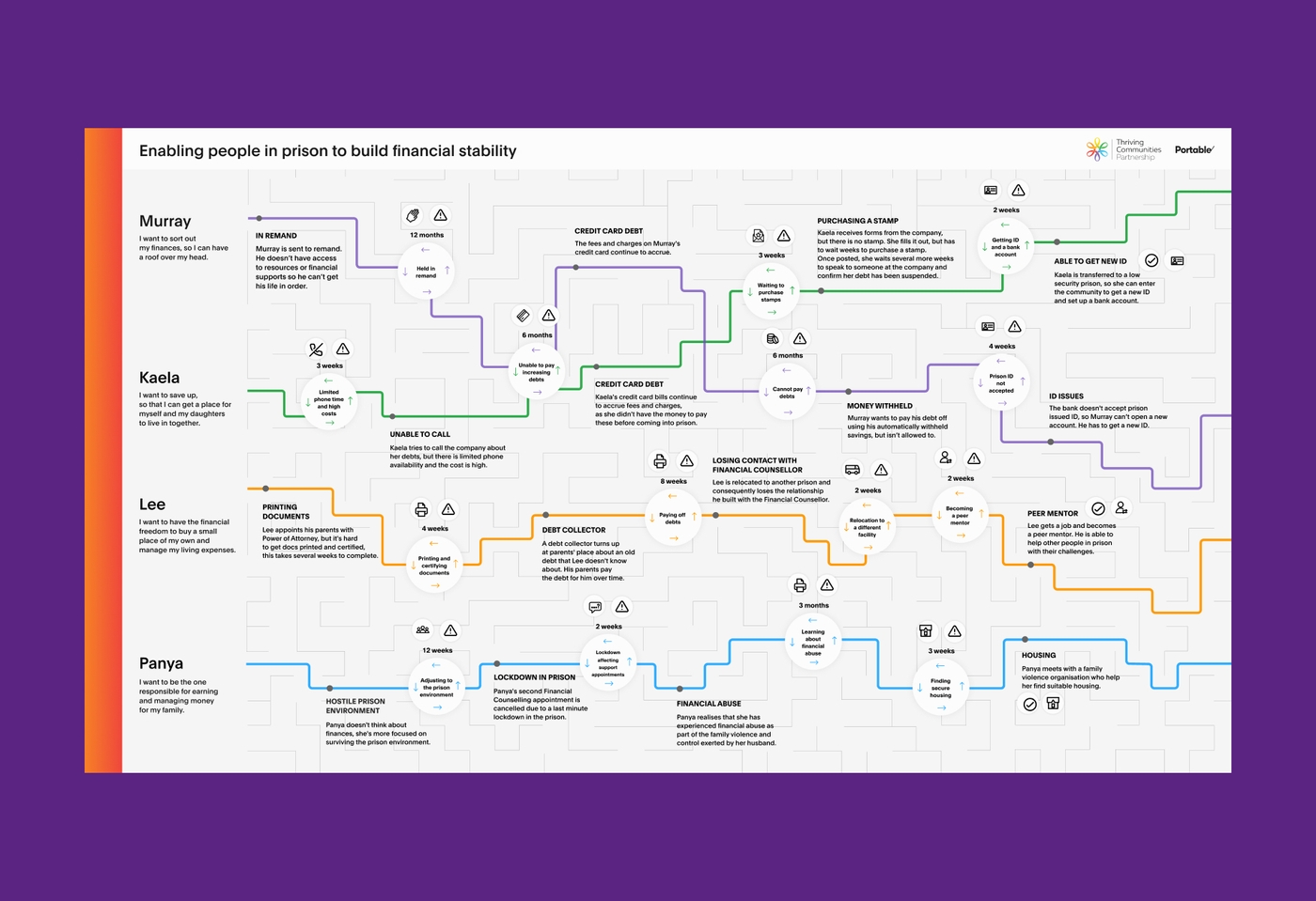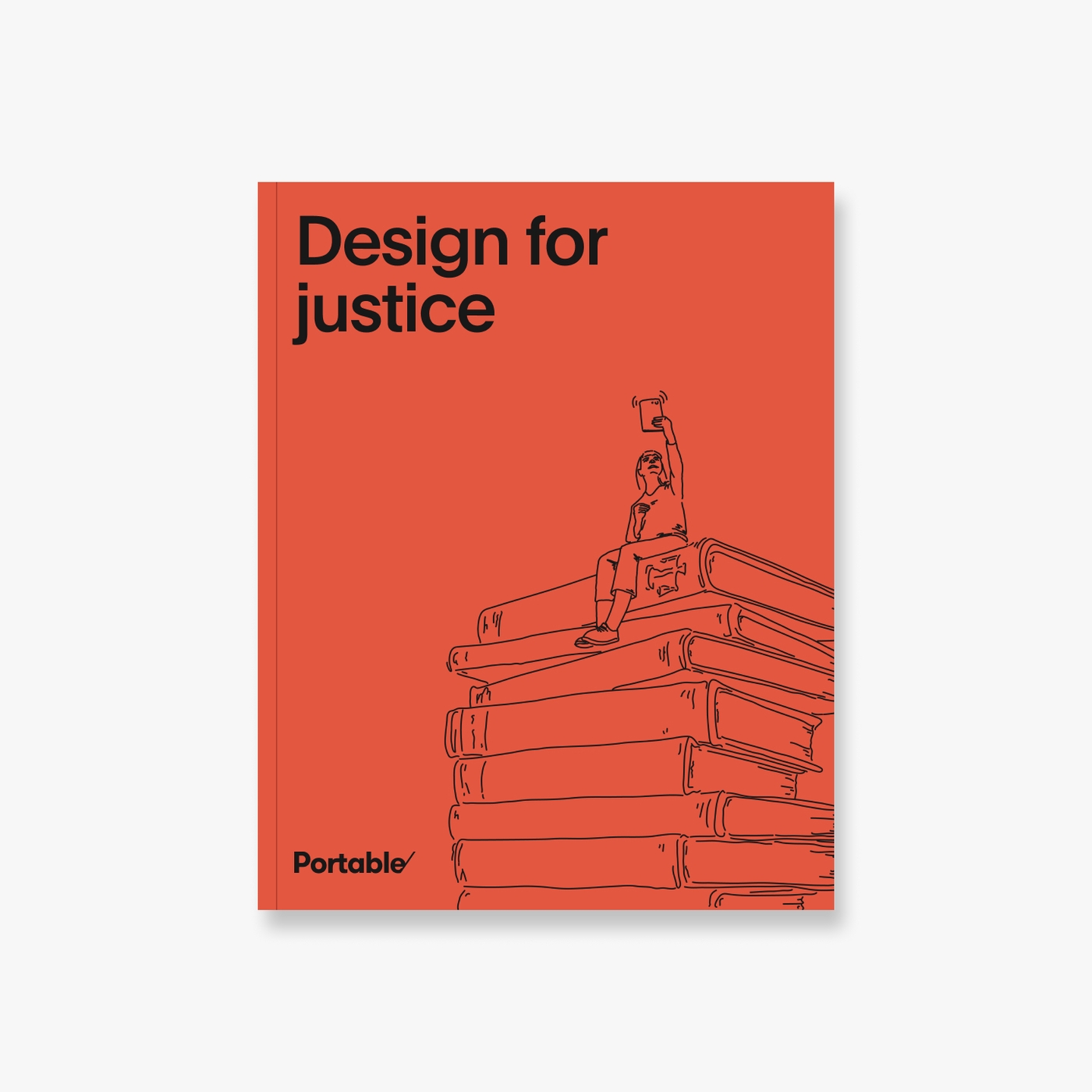
We take the opportunity to jump into legal design wherever we can; we’re passionate about creating the conditions for equal access to justice and designing accessible and inclusive outcomes for the people who need them the most. We were excited to collaborate with Thriving Communities Partnership to better understand how to build financial stability for people in prison, a group of people who are notoriously underserved and disadvantaged by the existing financial management systems. We were excited by Thriving Communities Partnership’s passion for creating outcomes that encourage equality and ensure that everyone has the ability and access to successfully manage their own financial wellbeing.
Thriving Communities Partnership is a not-for-profit organisation based in Melbourne. Their goal is to ensure that every Australian has fair access to the modern essential services that are needed to thrive in contemporary Australia. This includes services such as utilities, financial services, telecommunications and transport. Thriving Communities Partnership takes a truly human-centred approach by focusing on co-designing and developing community-led solutions that reduce barriers to access, leading to sustainable and effective change that supports the economic wellbeing of every Australian.
Our project was part of a larger piece of work, looking at many aspects of financial wellbeing and stability for people in prison. From previous research, Thriving Communities Partnership were already aware of:
- the connection between financial instability and recidivism;
- the exponential growth of fines and debts for people in prison; and
- the socioeconomic and health challenges that can disproportionately affect people in prison.
Using this information as a starting point, we dived into more deeply understanding the specific challenges and barriers faced by people in prison that inhibit them from being able to resolve their debts and build financial stability before leaving prison.
The Challenge
Why do we need to create financial stability for people in prison?
Financial instability is tightly connected with recidivism rates, people who leave prison with large debts often feel they have no choice but to turn to further criminal activity in order to repay these debts, creating a vicious ongoing cycle of criminal behaviour and incarceration. Our goal was to deeply understand the financial journey of people with lived experience of the prison system. This included understanding the barriers and opportunities that currently exist and effect whether or not a person in prison is able to resolve their financial challenges.
As a result of our research, Thriving Communities Partnership will be able to collaborate with people with lived experience of prison and Australian service providers to resolve these barriers in order to build greater financial wellbeing for people in prison.
What are the barriers to building financial stability?
Sadly, a disproportionately large percentage of the prison population has experienced or continues to experience disadvantage. This includes homelessness, low levels of education and trauma as well as physical and/or mental health challenges. Not only do these disadvantages influence a person’s likelihood to become incarcerated, they also form barriers that people must overcome in order to build financial stability.
People in prison often experience ‘hidden debts’, which can quickly grow to unmanageable levels. It is not uncommon for people in prison to have cars, houses and personal items repossessed to cover their debts, leaving them in a worse position when they leave prison.
Resolving these debts is very difficult as people in prison only receive a minimal salary, have costly expenses in prison (such as phone costs) and are excluded from standard debt resolution processes. Charitable services exist to support people in prison with debt resolution. However, accessing these services can be difficult, as not all people are aware they exist and last minute lockdown measures and prison relocation can lead to cancelled appointments or loss of contact with the service provider.
Our Approach
Initial Research
Prior to the start of this project, Thriving Communities Partnership had already completed an initial phase of work, which resulted in a series of insights and quantitative learnings which we were able to access and learn from. We were also able to immerse ourselves in research from a wide range of sources including Financial Counselling Australia, Australian Institute of Health and Welfare and Corrections Victoria among others. As a result, we developed an understanding of the high level challenges facing people in prison. Our initial research helped us build an understanding of the facts and figures. However, we were lacking a detailed understanding of how these facts and figures affect people’s lives individually. Using the initial research as the starting point, we developed learning outcomes and an approach for our qualitative research.
Learning from people with lived experience
Thriving Communities Partnership’s focus on community collaboration and human-centred design is aligned with our own passion for speaking to and learning from people with lived experience. In addition to spending time quantitatively researching the many and varied challenges facing people in prison, we were fortunate to speak with 22 people who were currently incarcerated or had previously been in prison through a series of individual interviews and group think tanks. As a result of these discussions, we were able to gain a deeper understanding of their individual and collective experiences, frustrations, worries and needs.
The prison system is a highly complex environment, making resolving financial challenges even more difficult. Our conversations gave us the opportunity to gain insight into the ways people in prison attempt to overcome these financial challenges, how they are personally affected by the barriers that exist and what these barriers can mean for their lives both within prison and once they leave. People in prison and their family and friends can be affected by financial challenges in so many different ways. Our conversations helped to bridge the gap between initial research conducted by Thriving Communities Partnership and the quantitative research available to us. We were incredibly lucky to speak to people who were happy to openly share their experiences, many of which were heartbreaking, helping us to gain a better understanding of what people in prison face both in prison and after they leave. The stories shared with us helped to shape the design considerations and approach that were the basis of our research outcomes.
Personas
In order to genuinely represent the different stories we heard from people with lived experience, we chose to create a series of personas, an experience map and a report. We learned that no two experiences are the same, everyone has an individual experience of the prison system and their challenges are also very individual. While one person may struggle with literacy, another may have come from a background of family violence. Finding ways to build financial stability means recognising the highly individualistic nature of the prison experience and identifying flexible options that meet people where they are. We were determined to reflect these nuances and the individualistic nature of the prison experience in the design artefacts that we created.
Understanding personal circumstances
Another consideration was the prevalence of particular life factors that had a significant influence on people and created further complications to debt resolution. For example, a significant percentage of the prison population is illiterate and innumerate, making it very difficult for people to engage with paper processes, proactively seek out information and manage their finances on their own.
Experience map
In order to highlight the human experience at the centre of our design artefacts and build empathy with the reader, we used a combination of first-person language and visual design. We designed our personas to share their story in their own ‘voice’ from their own perspective. We also centred the persona design around life experiences, motivations, behaviours and challenges, rather than demographics. In our experience map, we used visual design to bring to life the various barriers and supportive factors experienced by our personas. The experience also provided an opportunity to highlight future state opportunities for change, aligned with the barriers experienced by our personas.

Final report and assets
At the end of this project we delivered an experience map, personas and a report which captured:
- A deeper understanding of the experience of being incarcerated and how this impacts an individuals’ ability to resolve their financial challenges;
- A summary of the personal and systemic barriers that negatively impact financial stability; and
- Opportunities that could be implemented to overcome these barriers and build financial stability for people in prison.
Outcomes
Financial stability and the importance of equality for people who have experienced disadvantage is an important and ongoing conversation. The design artefacts created will enable Portable to continue to step into these conversations with partners across the legal industry, as well as partners in other adjacent industries.
Our intention was to ensure that the human experience and variety of individual stories we heard, could be communicated through these artefacts. Our goal was to create artefacts that would enable anybody, regardless of their level of subject matter expertise, to empathise with the experience that someone who is currently or has been incarcerated might have had.
One of the biggest challenges to creating change in this space is apathy and a lack of empathy for or interest in the challenges experienced by people with lived experience of prison.
By building empathy with the reader, we hope to engender sustainable change that leads to greater economic equality and financial stability for all Australians.
Project Team
- Tom Morris - Senior Digital Producer
- Joanne Osbourne-Taylor - Lead Design Strategist
- Luke Thomas - Senior Design Strategist
- India Lock - Design Strategist
- Maria Garcia - Experience Designer
- Naomi Wilson - Senior Client Partner
Download our free guide to transforming justice today
